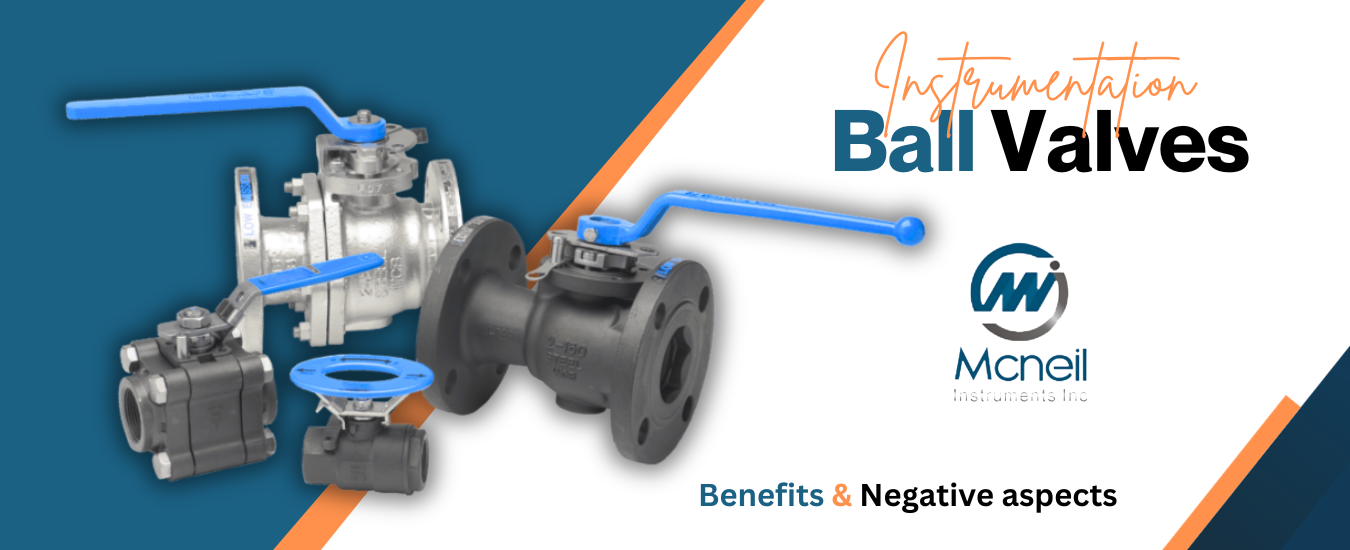Ball valves are flow control devices that rotate a ball to regulate fluid flow; they open when in alignment and close at a ninety-degree angle. They are robust and dependable and good at control and shutdown, but they don’t have the delicate control needed for slowdown. They handle high pressures and temperatures and are commonly used in industrial settings due to their ease of operation, repairability, and adaptability. They function effectively and are offered in a range of sizes and materials, such as plastic, metal, and metal covered with ceramic. When closed, though, they could retain water and cause freezing problems in colder climates. Specific designs, such as freeze-tolerant ball valves, take care of these issues and guarantee workable solutions for various situations.
Benefits & Drawback Aspects of Ball Valves
Ball valves are incredibly strong, long-lasting, and reasonably priced. They are easy to install and increase the efficiency of pipe systems with their quarter-turn operation. Because of its durability, ball valves are widely used in a variety of sectors, such as water treatment facilities, petroleum refineries, and chemical processes.
While choosing the right valve for your application, you should be aware of a few disadvantages even if they’re a simple option for the majority of applications. We at Mcneil Instruments Inc. assist companies in selecting the appropriate valves for their needs. Here, we go over the benefits and drawbacks of ball valves.
Mcneil Instruments Inc. is the Ball Valves Manufacturers
A hollow, revolving ball serves as the flow control element of a ball valve, which has a cylindrical form. The hole through the ball faces the flow while it is open, allowing fluid to pass through. The ball shuts and the fluid flow through the valve ceases when the valve handle is twisted 90 degrees. The handle (or lever), when the valve is open, is perpendicular to the direction of flow, making it simple to see the valve’s condition visually. Ball valves’ lengthy service life and dependable sealing abilities are their main advantages.
The Benefits of Ball Valves
The primary benefits of applying a ball valve are enumerated below:
Excellent Effinity: Ball valves are regarded as high recovery valves because of their large opening size, minimal pressure drop, and high flow capacity. When the valve is fully open, there is minimal resistance or turbulence in the fluid flow.
Versatile Use: Ball valves operate on a straightforward quarter-turn (90-degree) and are both effective and practical. The valve is also simple to install and remove because of its compact size and relatively low weight.
Easy to Maintain: Ball valves are easier to use and need less maintenance than other valve designs. The packing seal on the valve stem does not wear out or fail readily since the ball valve stem spins without axial movement. Ball valves are simple to remove, fix, and replace if any parts get damaged.
Eco-Friendly: Ball valves are less expensive than other, more intricate valve designs. They are also less expensive to maintain since they require less care. put into practice over time.
Strong and well: Because of its resistance to high pressure, ball valves are considered to be one of the most durable valve types. They may be employed in a multitude of settings and industries due to their broad range of materials.
Drawback Aspects of ball valves
The following is a list of ball valves’ major drawback aspects:
Accurately Blockages: They are not appropriate for slurry applications because of the voids surrounding the ball and seats. Slurries and other viscous liquids tend to clog or congeal inside of the valve cavities, increasing the working torque significantly and sometimes making the valve unusable.
Trouble with Permanent Throttling: Ball valves should not be utilized for long-term throttling; they should only be used in completely open or fully closed positions. Operating in a partially open position for extended periods might cause the soft seats of the valve to flex around the edge of the hole in the ball, perhaps locking it in that position, in addition to having limited precision in managing the flow rate. Ball valves with a unique “V” port shape that can offer precise flow control features are available in modern designs.
Conclusion:
Ball valves are basic mechanical devices that are used in plumbing systems to regulate fluid flow. The majority of industrial applications are perfect for them because of their affordability and ease of use. Ball valves are ideal for a variety of settings and applications because of their features. They are frequently the greatest option when searching for an effective and affordable valve solution, despite their drawbacks.
Selecting the appropriate valve for your application may be made easier if you are aware of the benefits and drawbacks of ball valves. Want more guidance? The Mcneil Instruments is the Biggest Manufacturer, Supplier, and Exporter in India. Contact us.
#ballvalves #benefits #drawbacks






